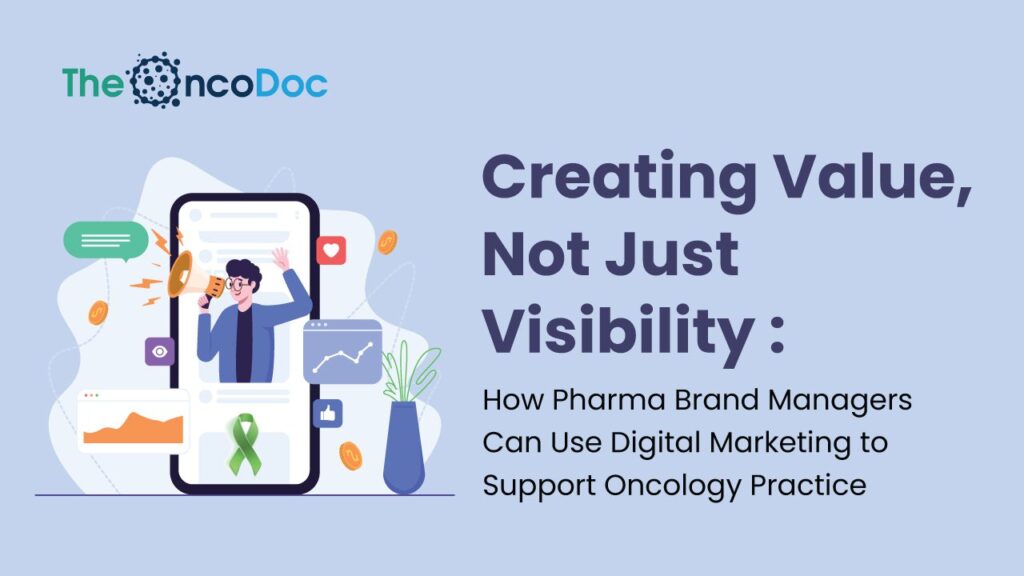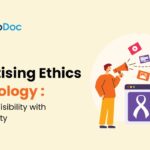Introduction: Moving Beyond Digital Noise in Oncology
In oncology, every prescription is a decision rooted in trust, evidence, and clinical context. Yet, many pharma digital campaigns still prioritize visibility- impressions, reach, and clicks-without addressing a more critical question: Are we genuinely helping oncologists do their jobs better?
As digital channels dominate pharma-oncologist communication, brand managers must shift from attention-seeking to value-creating strategies. The goal isn’t simply to be seen, it’s to be useful, credible, and clinically relevant.
This article explores how pharma brand managers can leverage digital marketing to offer meaningful support to oncology practices, drive deeper clinical engagement, and differentiate their brands in a crowded, high-stakes market.
Why Visibility Alone Falls Short in Oncology
Oncologists today are exposed to thousands of digital touchpoints- emails, LinkedIn messages, webinar invites, and ad banners. But only a handful truly earn their trust, attention, or time.
Here’s why traditional digital metrics like click-through rate (CTR) and cost per mille (CPM) fall short in oncology:
- They don’t measure clinical relevance
- They ignore emotional and ethical nuance
- They often prioritize brand goals over HCP needs
“In cancer care, an ad that offers clarity, a guide, or a tool is remembered longer than the one that just announces a brand.”
– Dr. Ankur Jaiswal, Hemato-Oncologist, Lucknow
What Value Looks Like to an Oncologist in the Digital World
Pharma brand managers must reframe success from “How many saw us?” to “How many were helped by us?”
Oncologists value digital assets that:
- Simplify clinical decision-making
- Save time during patient consultations
- Support evidence-based treatment planning
- Enable patient education and adherence
- Address real-world challenges like side effects or co-morbidities
Creating value means aligning digital content and tools with these everyday needs.
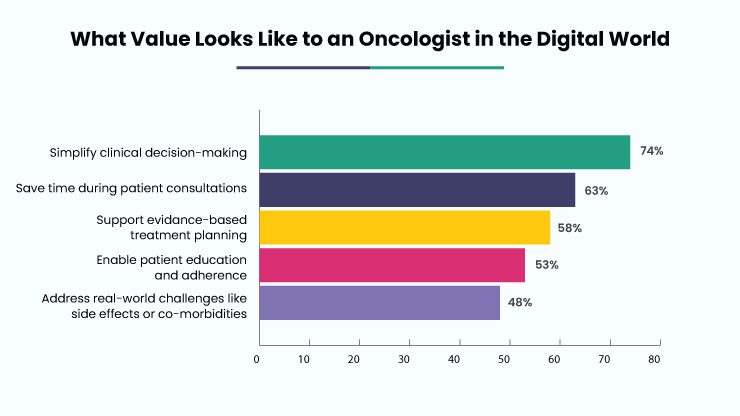
1. Build Clinical Utility into Every Digital Asset
Don’t just tell oncologists what your drug does- help them decide when and how to use it.
Valuable Digital Tools:
- Interactive treatment algorithms based on staging and biomarkers
- Side effect management guides by indication and patient type
- Tumor board-ready slide decks for common decision dilemmas
- Switching protocols for biosimilars and generics
- Clinical calculators for dosage personalization in renal or hepatic impairment
Tip: Host these resources on a mobile-friendly HCP portal or app, accessible during clinic hours even between patients.
2. Go Deep on Real-World Evidence, Not Just Trial Data
RCTs are essential but oncologists also want to know how your therapy performs in real-life settings.
They look for data on:
- Indian populations and ethnic diversity
- Elderly patients and those with co-morbidities
- Rural or resource-constrained settings
- Long-term outcomes and survivorship
Valuable Formats:
- Case series co-authored with local KOLs
- Infographics comparing real-world and trial data
- Interactive dashboards segmented by region, tumor type, or treatment line
- Recorded expert panels discussing real-world treatment gaps
By surfacing practical insights, brand managers can meet oncologists where clinical complexity lives.
3. Respect Time: Deliver Micro-Content with Macro-Value
Today’s oncologists are time-starved. Instead of lengthy articles or hour-long webinars, offer:
- 60-second videos on dosage titration or safety updates
- 2-page quick-reference guides on therapy sequencing or biomarker testing
- Chatbot summaries of new guidelines from ESMO, NCCN, or ASCO
- Infographic summaries of meta-analyses or head-to-head studies
Channel Match:
- Use email for in-depth toolkits
- Use LinkedIn for thought-leader insights and short takes
- Use WhatsApp or Telegram for rapid-fire, digestible updates
Creating modular content that fits into the oncologist’s workflow increases both consumption and credibility.
4. Enable Patient Communication and Caregiver Support
Digital marketing can also bridge the gap between clinical knowledge and patient understanding.
Valuable Assets for Oncologists to Share:
- Explainer videos for patients on immunotherapy or targeted therapy
- Multilingual consent templates and frequently asked questions
- Printable chemotherapy preparedness checklists
- Emotional support content for caregivers facing burnout
These materials can be easily shared via QR codes, patient portals, or messaging apps during consultations, making the physician’s job easier and the patient journey smoother.
5. Build Trust with Transparency and Personalization
In oncology, credibility is currency. Digital marketing must earn trust before it earns conversions.
Do This:
- Share clear mechanisms of action (MOAs) along with side effect disclosures
- Include local regulatory approval status (e.g., DCGI, ICMR)
- Personalize email content based on sub-specialty (e.g., breast vs lung vs hematologic)
- Feature real Indian clinicians- not stock imagery in testimonial campaigns
Avoid over-polished messaging. Oncologists are more likely to engage with authentic, experience-driven insights.
6. Align Field Reps and MSLs With Digital Tools
Digital is not a silo- it should be a force multiplier for field efforts.
- Reps should use email open rates and toolkit downloads to personalize outreach
- MSLs should be looped into scientific questions or feedback from digital touchpoints
- Regional content engagement should shape in-clinic detailing priorities
Pro Tip: Integrate your CRM and marketing automation tools to create closed-loop feedback between digital and field teams.
7. Measure What Matters: The Value KPIs
Beyond reach and impressions, track metrics that indicate impact and relevance:
- Frequency of tool use (Are oncologists revisiting decision aids?)
- Average time spent on educational content.
- Number of post-engagement rep meetings.
- Peer-sharing activity (Was your content forwarded?)
- Sentiment analysis from short-form surveys (“Did this help your practice?”)
Every engagement should build clinical confidence, not just conversion.
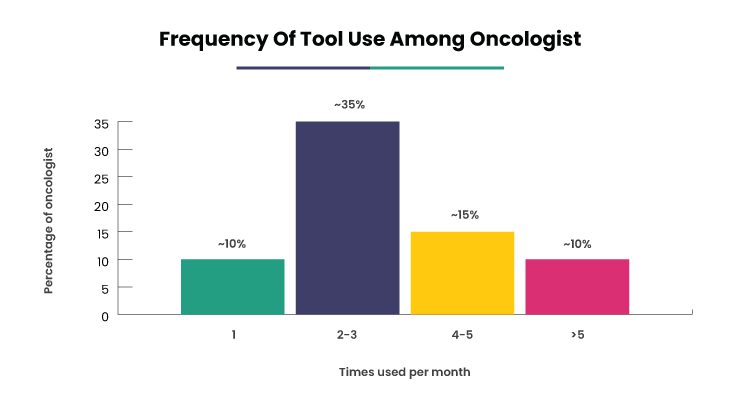
Mini Case Example: Value-Centered Digital Campaign for Immunotherapy
Brand Goal: Increase awareness and uptake of a new immunotherapy for Stage III NSCLC
Digital Strategy:
- Launched a clinical decision tool: “Is your patient ready for immunotherapy?”
- Ran a Telegram-based tumor board series featuring regional KOLs.
- Created a patient-facing explainer in 5 regional languages.
- Equipped field reps with “Top 10 Questions Asked” discussion decks.
Results:
- 45% of oncologists used the decision tool more than 3 times/month
- 68% shared the patient explainer with at least 5 patients
- Reps reported 35% shorter sales cycles in digital-first clinics
This initiative not only improved awareness- it enabled better care.
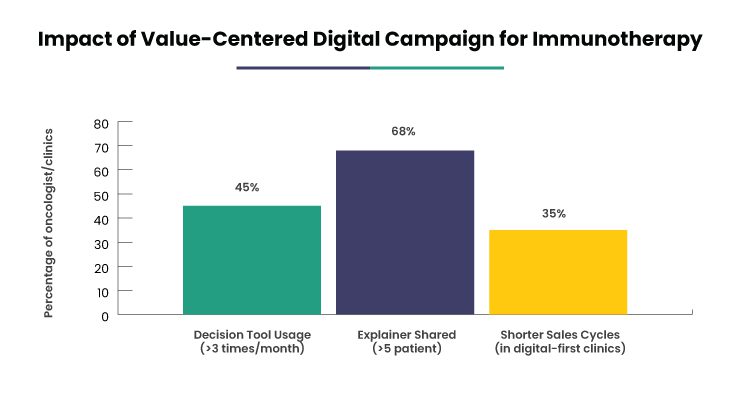
Conclusion: Pharma Marketing Must Serve the Practice, Not Just the Brand
Digital marketing to oncologists must reflect the gravity of cancer care. It’s not about showing up- it’s about showing up with value.
- Support their clinical practice
- Respect their time and attention
- Strengthen their treatment decisions
That’s how pharma brands can shift from promotion to partnership and make a lasting impact in oncology.
The Oncodoc team is a group of passionate healthcare and marketing professionals dedicated to delivering accurate, engaging, and impactful content. With expertise across medical research, digital strategy, and clinical communication, the team focuses on empowering healthcare professionals and patients alike. Through evidence-based insights and innovative storytelling, Hidoc aims to bridge the gap between medicine and digital engagement, promoting wellness and informed decision-making.

